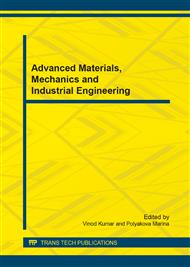[1]
Behrend, A; Abele, E; Emrich, A (2007). Together - one after another – cellular manufacturing as an economic alternative for complete machining (in German). Werkstatt und Betrieb 12, p.68–72.
Google Scholar
[2]
Womack, J; Jones, D; Roos, D (1990). The machine that changed the world. Free Press, New York.
Google Scholar
[3]
Roessler, M; Wolff, M; Abele, E (2013). Design and simulation based assessment of lean material flows considering imprecision. 6th MCPL Conference. Fortaleza, Brazil, September 11-13, (2013).
DOI: 10.3182/20130911-3-br-3021.00021
Google Scholar
[4]
Sturm, F; Muetze-Niewoehner, S; Gaertner, T; Schreiber, S; Gregorius, C; Werkle, M (2009). Growth through change to solution providers (in German). Werkstattstechnik online 7-8, p.518–525.
DOI: 10.37544/1436-4980-2009-7-8-518
Google Scholar
[5]
Detty, R; Yingling, J (2000). Quantifying benefits of conversion to lean manufacturing with discrete event simulation. A case study. Journal of Production Research 38(2), p.429–445.
DOI: 10.1080/002075400189509
Google Scholar
[6]
McDonald, T; van Aken, E; Rentes, A (2002). Utilising simulation to enhance value stream mapping. A manufacturing case application. Journal of Logistics Research and Applications 5(2), p.213–232.
DOI: 10.1080/13675560210148696
Google Scholar
[7]
Standridge, C; Marvel, J (2006). Why lean needs simulation. Winter Simulation Conference 2006. In: Perrone, L et al. (Eds. ): Proceedings of the 2006 Winter Simulation Conference. IEEE, p.1907–(1913).
DOI: 10.1109/wsc.2006.322973
Google Scholar
[8]
Abdulmalek, F; Rajgopal, J (2007). Analyzing the benefits of lean manufacturing and value stream mapping via simulation. Journal of Production Economics 107(1), p.223–236.
DOI: 10.1016/j.ijpe.2006.09.009
Google Scholar
[9]
Azadeh, A; Seifoory, M; Abbasi, M (2007). Integration of simulation and fuzzy madm for modelling and assessment of fuzzy parameters. Industrial and Systems Engineering 6(4), p.483–502.
DOI: 10.1504/ijise.2010.036029
Google Scholar
[10]
Lian, Y; van Landeghem, H (2002).
Google Scholar
[11]
Abele, E; Wolff, M; Roessler, M (2012). Simulation based evaluation of machine tool-inralogistics systems (in German). Zeitschrift fuer wirtschaftlichen Fabrikbetrieb 107(7-8), p.503–507.
Google Scholar
[12]
Domschke, W; Scholl, A (2005). Fundamentals of business economics (in German). Springer, Berlin.
Google Scholar
[13]
Maerz, L; Krug, H; Rose, O; Weigert, G. (2011). Simulation and optimization of production and logistics (in German). Springer, Berlin.
Google Scholar
[14]
Zadeh, L (1965). Fuzzy sets. Journal of Information and Control 8(3), p.338–353.
Google Scholar
[15]
Chen, S; Hwang, C; Hwang, C. (1992). Fuzzy multiple attribute decision making. Methods and applications (lecture notes in economics and mathematical systems). Springer, New York.
DOI: 10.1007/978-3-642-46768-4_5
Google Scholar
[16]
Geldermann, J; Sprengler, T; Rentz, O (2000). Fuzzy outranking for environmental assessment. Case study: Iron and steel making industry. Fuzzy sets and systems 115, p.45–65.
DOI: 10.1016/s0165-0114(99)00021-4
Google Scholar
[17]
Cramér, H (1946). Mathematical methods of statistics. Princeton University Press, USA.
Google Scholar
[18]
Hwang, C; Yoon, K (1981). Multiple attribute decision making. Methods and applications. Kluwer Academic Publishers, Boston.
Google Scholar
[19]
Belton, V; Stewart, T (2002). Multiple criteria decision making. An integrated approach. Kluwer Academic Publishers, Boston.
Google Scholar
[20]
Brans, J; Mareschal, B; Vincke, P (1984). PROMETHEE: A new family of outranking methods in multicriteria analysis. Journal of Operational Research, p.477–490.
Google Scholar
[21]
Queiruga, D; Walther, G; Gonzales-Benito, J; Sprengler, T (2008). Evaluation of sites for the location of weee recycling plants in Spain. Journal of Waste Management 28, p.181–190.
DOI: 10.1016/j.wasman.2006.11.001
Google Scholar


